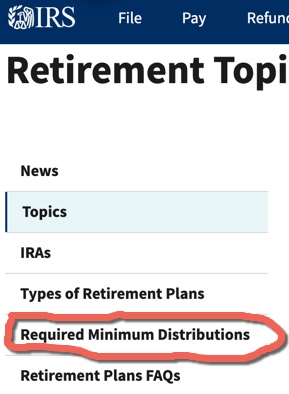New Rules Push Back RMD Start, Reduce Penalties
Category: Financial and taxes in retirement
January 20, 2023 — The end of the year presented several gifts to well off folks with substantial IRA, 401(k), or 403(b) balances. The biggest is that, thanks to the Secure 2.0 Act of 2022, the new age for taking Required Minimum Distributions (RMDs) from those accounts now begins at age 73, up from 72. That change started on Jan. 1, 2023; beginning on Jan. 1, 2033, the age goes up to 75. People who were already required to take those distributions must continue to make them.
The Act also provided a big benefit to people who fail to take their RMDs on time. Previously the penalty was an onerous 50% of the required distribution. Now that is reduced to 25%, and 10% if corrected in a “timely manner”. Catch up contributions for people over 50 and 60 also were increased, and there were other provisions to encourage employers to help employees save more for retirement.
So what is the effect of these delayed RMDs?
There has been considerable debate about whether delayed RMDs are a good or a bad thing. Here are some of the points made:
– First, people who can afford to delay taking money out of their tax-deferred retirement accounts are usually pretty well off. Those who are scraping by on Social Security and other savings are probably already taking money out of their retirement accounts, if they have any to take out. So the delay seems to have little impact on lower income people.

-Those who can use other funds to support their lifestyle instead of IRA and 401(k) withdrawals should benefit from these delays on a tax basis. That’s because RMDs are taxed as ordinary income, which usually pushes people into a higher tax bracket. So, if those funds can remain in an untaxed account for a few more years, that will not only save on current taxes but also let those savings grow even higher.
-The SECURE 2.0 Act also eliminates RMDs for qualified employer Roth plan accounts (401(k)s Beginning in 2024. Up until now RMDs were required for those accounts.
-Some people have warned that delaying distributions will make them larger, not only pushing folks into higher tax brackets, but also contributing to higher Part B Medicare premiums. (The maximum additional premium is $395.60/month on joint MAGI (Modified Adjusted Gross Income) over $700,000).
Bottom line
Anyone who doesn’t need the money from these accounts before age 73 (and 75 starting in 2033) will benefit by not having to take the money out so early. Although their MAGI will probably cost them additional Medicare premiums, this should be slight impact compared to not having to pay taxes on several years of distributions.
For further reading:
CNET Explanation of Secure 2.0 Act 2022






Comments on "New Rules Push Back RMD Start, Reduce Penalties"
Clyde says:
Although those who are fairly well off can often avoid taking RMDs until they’re required to (now age 73 as the article points out), a lot of middle class folks can avoid taking RMDs if they have enough Social Security, pension income and outside savings. So this new law pushing the required RMD back a year can be helpful for quite a few more than wealthy people, even if just for a year. Also, as the article indicates, if you’re currently required by age to take RMDs, the new law pushing the age back obviously doesn’t apply.
JCarol says:
This delay helps the many seniors who want to work past 70.
Hubby & I are retiring at in 2023, but would have worked a few more years if not for federal income taxes on 85% of our SS.
We've committed to our customers to stay in business through 2023, despite knowing we'll get slammed hard by the IRS. (Now 70, DH starts drawing maximum SS this month against his own earnings record, rather than spousal benefits.)
If RMDs were still required at 70-1/2, more seniors would be put off from working past that age. We'd have quit working December 2022 if that were the case.